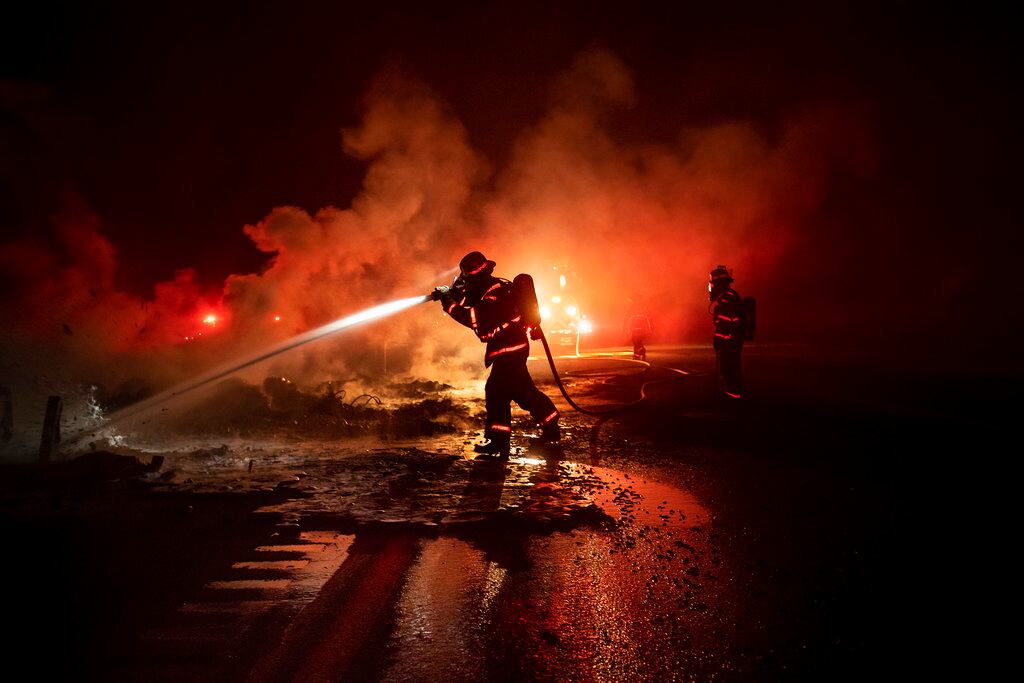HUTCHINSON, Kan. — A 1958 U.S. Navy plane, once used to spot enemy submarines, will now serve as the newest asset for Kansas wildfires.
The privately owned twin-engine recently arrived at the Hutchinson Regional Airport from a Nevada museum.
Stripped of its paint and with exposed wires, Bill Garrison’s Grumman S-2 Tracker looks like a death trap. But the 56-year-old owner of Ag Air Service said the bones are solid since the plane underwent regular maintenance while fighting fires for the California Department of Forestry and Fire Protection.
Plus, the wires are only exposed until maintenance is finished this fall.
It took 18 months to get the plane certified with the Federal Aviation Administration and enter the first-ever "call when needed" contract with the Kansas Forest Service.
It will be ready to go before the spring, when Kansas has historically seen its most massive fires.

The six largest fires in Kansas history occurred over the last 23 years. Of those, four occurred in March and two in February, The Hutchinson News reported.
"We are really excited to have him available, and I think it will be a real benefit to the region, to south-central Kansas, as well as the rest of the state," said Rodney Redinger, a KFS assistant fire management officer for operations and training. "It's one of those things that we have all these plans in place and we hope to never use him."
Redinger said the contract for $4,000 an hour is based on the rate the U.S. Forest Service pays pilots elsewhere for fighting fires. The KFS and local agencies will foot the bill through a cost-share, he said.
The plane will benefit the region since the Hutchinson man can respond in minutes, compared to the couple of hours it could take the Kansas National Guard.
Until its deployment, the investment has all been on Garrison.
Garrison started his Nickerson-based crop-dusting company in 2000. He was first called to use his planes in February 2006, when a Burrton fire burned 8,800 acres.
Redinger worked for the KFS then, but happened to be on the front lines as a Burrton Fire Department volunteer. Redinger said he knew about crop dusters being used in Western Kansas to help fight fires and word spread about Garrison’s business.
He flew in with his 1980 Air Tractor, dumping 500 gallons at a time. Garrison said he's helped firefighters battle flames from above about a half-dozen times in all.
Redinger said the Burrton drops went in areas firefighters couldn't go, where a structure was at risk. The building survived, but Redinger's not sure he can fully credit the aerial assault.
However, Redinger said the 125 mph fly-bys dropping hundreds of gallons "take the punch" out of the flame, knocking flames 50-plus feet in length down to 20 feet.
“I know that happened quite a bit on the Highlands Fire,” Redinger said.
RELATED

The March 2017 Highlands Fire burned more than 6,000 acres and destroyed at least 10 homes. Garrison lives in the evacuated area, but he was in the air, dropping water to suppress the flames.
Garrison said it was the 2017 fire that made him realize he needed more capacity and a plane intended for battling wildfires. After narrowing down his search, Garrison found the plane he wanted in October at the Cactus Air Force Wings and Wheels Museum.
Garrison said he spent two months in Carson City, Nevada, working on the plane before flying it back.
"Airplanes are like cars, if they've had good maintenance they will last quite a while," Garrison said. About the current drip of oil from one of the engines, he said: "If they ain't leaking oil, there isn't any oil."
Garrison wouldn't say the purchase price of the plane.
"All that work probably cost more than what (I) paid ... on the purchase price," he said.
Unlike his crop duster, the Grumman S-2 Tracker weighs more than the payload it can carry, so it's easier to drop all at once or in increments. The plane from 1958 has four different drop options and compartments for the 850 gallons or roughly 7,055 pounds.
Now Garrison can make multiple attacks on one fire before having to reload water or flame retardants. The 3-inch-wide hose hookup in the back of the plane also allows for a "hot load" — while the engine is still running — in under three minutes.
“I felt it needed to be done,” Garrison said. “That and I like airplanes.”




